National Security Advisor (United States)
The Assistant to the President for National Security Affairs (APNSA), commonly referred to as the National Security Advisor (NSA) or at times informally termed the NSC Advisor,[2][3] is a senior aide in the Executive Office of the President, based at the West Wing of the White House, who serves as the chief in-house advisor to the president of the United States on national security issues. The National Security Advisor is appointed by the president and does not require confirmation by the Senate,[4] but an appointment of a three or four-star general to the role requires Senate reconfirmation of military rank.[5]
| Assistant to the President for National Security Affairs | |
|---|---|
 | |
 Robert O’Brien since September 18, 2019 | |
| Executive Office of the President | |
| Member of | National Security Council |
| Reports to | President of the United States |
| Appointer | President of the United States |
| Constituting instrument | National Security Presidential Memorandum–4[1] |
| Formation | 1953 |
| First holder | Robert Cutler |
| Deputy | Deputy National Security Advisor |
| Website | WhiteHouse.gov/NSC |
The National Security Advisor participates in meetings of the National Security Council (NSC) and usually chairs meetings of the Principals Committee of the NSC with the Secretary of State and Secretary of Defense (the meetings not attended by the president). The National Security Advisor is supported by NSC staff who produce research and briefings for the National Security Advisor to review and present, either to the National Security Council or directly to the president.
Role
The influence and role of the National Security Advisor varies from administration to administration and depends not only on the qualities of the person appointed to the position, but also on the style and management philosophy of the incumbent president.[6] Ideally, the National Security Advisor serves as an honest broker of policy options for the president in the field of national security, rather than as an advocate for his or her own policy agenda.[7]
The National Security Advisor is a staff position in the Executive Office of the President and does not have line or budget authority over either the Department of State or the Department of Defense, unlike the Secretary of State and the Secretary of Defense, who are Senate-confirmed officials with statutory authority over their departments.[8] The National Security Advisor is able to offer daily advice (due to the proximity) to the president independently of the vested interests of the large bureaucracies and clientele of those departments.[6]
In times of crisis, the National Security Advisor is likely to operate from the White House Situation Room or the Presidential Emergency Operations Center (as on September 11, 2001),[9] updating the president on the latest events in a crisis situation.
History
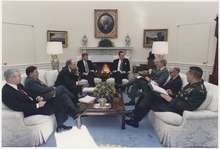
The National Security Council was created at the start of the Cold War under the National Security Act of 1947 to coordinate defense, foreign affairs, international economic policy, and intelligence; this was part of a large reorganization that saw the creation of the Department of Defense and the Central Intelligence Agency.[10][11] The Act did not create the position of the National Security Advisor per se, but it did create an executive secretary in charge of the staff. In 1949, the NSC became part of the Executive Office of the President.[10]
Robert Cutler was the first National Security Advisor in 1953. The system has remained largely unchanged since then, particularly since President John Kennedy, with powerful National Security Advisors and strong staff but a lower importance given to formal NSC meetings. This continuity persists despite the tendency of each new president to replace the advisor and senior NSC staff.[10]
President Richard Nixon's National Security Advisor, Henry Kissinger, enhanced the importance of the role, controlling the flow of information to the president and meeting with him multiple times per day. Kissinger also holds the distinction of serving as National Security Advisor and Secretary of State at the same time from September 22, 1973, until November 3, 1975.[10][11]
List of National Security Advisors
| No. | Portrait | Name | Term of office[12] | President(s) served under | ||
|---|---|---|---|---|---|---|
| Start | End | Days | ||||
| 1 | Robert Cutler (1895–1974) | March 23, 1953 | April 2, 1955 | 740 | Dwight D. Eisenhower | |
| 2 | Dillon Anderson (1906–1974) | April 2, 1955 | September 1, 1956 | 519 | ||
| Acting |  |
William H. Jackson (1901–1971)[13][14][15] | September 1, 1956 | January 7, 1957 | 128 | |
| 3 | Robert Cutler (1895–1974) | January 7, 1957 | June 24, 1958 | 533 | ||
| 4 | 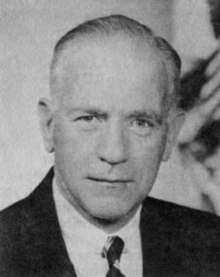 |
Gordon Gray (1909–1982) | June 24, 1958 | January 13, 1961 | 934 | |
| 5 |  |
McGeorge Bundy (1919–1996) | January 20, 1961 | February 28, 1966 | 1865 | John F. Kennedy |
| Lyndon B. Johnson | ||||||
| 6 |  |
Walt W. Rostow (1916–2003) | April 1, 1966 | January 20, 1969 | 1025 | |
| 7 | 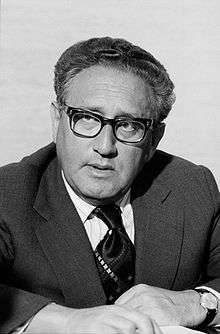 |
Henry Kissinger (1923–) | January 20, 1969 | November 3, 1975 | 2478 | Richard Nixon |
| Gerald Ford | ||||||
| 8 | Brent Scowcroft (1925–2020) | November 3, 1975 (first appointment) |
January 20, 1977 | 444 | ||
| 9 |  |
Zbigniew Brzezinski (1928–2017) | January 20, 1977 | January 20, 1981 | 1461 | Jimmy Carter |
| 10 | 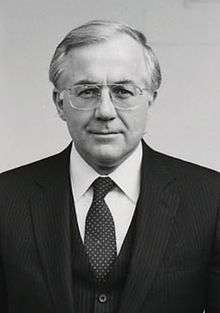 |
Richard V. Allen (1936–) | January 21, 1981 | January 4, 1982 | 348 | Ronald Reagan |
| 11 |  |
William P. Clark, Jr. (1931–2013) | January 4, 1982 | October 17, 1983 | 651 | |
| 12 | 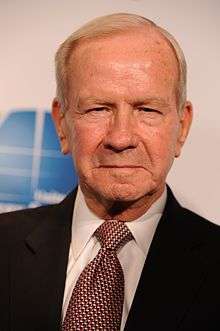 |
Robert McFarlane (1937–) | October 17, 1983 | December 4, 1985 | 779 | |
| 13 | John Poindexter (1936–) | December 4, 1985 | November 25, 1986 | 356 | ||
| 14 | Frank Carlucci (1930–2018) | December 2, 1986 | November 23, 1987 | 356 | ||
| 15 | Colin Powell (1937–) | November 23, 1987 | January 20, 1989 | 424 | ||
| 16 |  |
Brent Scowcroft (1925–2020) | January 20, 1989 (second appointment) |
January 20, 1993 | 1461 | George H. W. Bush |
| 17 | 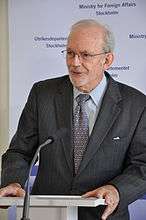 |
Anthony Lake (1939–) | January 20, 1993 | March 14, 1997 | 1514 | Bill Clinton |
| 18 | 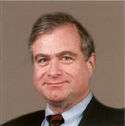 |
Sandy Berger (1945–2015) | March 14, 1997 | January 20, 2001 | 1408 | |
| 19 | 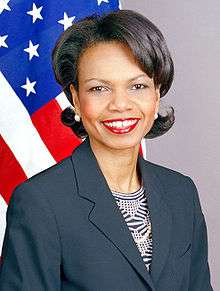 |
Condoleezza Rice (1954–) | January 22, 2001[16] | January 25, 2005[16] | 1464 | George W. Bush |
| 20 |  |
Stephen Hadley (1947–) | January 26, 2005[16] | January 20, 2009 | 1455 | |
| 21 |  |
James Jones (1943–)[17] | January 20, 2009 | October 8, 2010 | 626 | Barack Obama |
| 22 |  |
Tom Donilon (1955–)[18] | October 8, 2010 | July 1, 2013[19] | 997 | |
| 23 | .jpg) |
Susan Rice (1964–)[19] | July 1, 2013[19] | January 20, 2017 | 1299 | |
| 24 |  |
Michael Flynn (1958–) | January 20, 2017 | February 13, 2017 | 24 | Donald Trump |
| Acting | 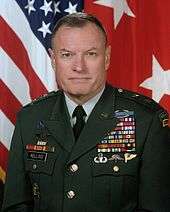 |
Keith Kellogg (1944–) | February 13, 2017 | February 20, 2017 | 7 | |
| 25 | 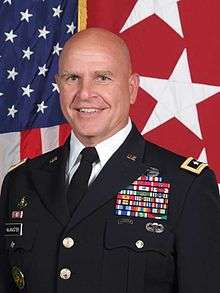 |
H. R. McMaster (1962–) | February 20, 2017 | April 9, 2018 | 412 | |
| 26 | .jpg) |
John R. Bolton (1948–) | April 9, 2018 | September 10, 2019 | 520 | |
| Acting | .jpg) |
Charles Kupperman (1950–) | September 10, 2019 | September 18, 2019 | 8 | |
| 27 |  |
Robert O’Brien (1966–) | September 18, 2019 | present | 332 | |
Brent Scowcroft held the job in two non-consecutive administrations: the Ford administration and the G.H.W. Bush administration. Robert Cutler also held the job twice, both times during the Eisenhower administration. Henry Kissinger holds the record for longest term of service (2,478 days). Michael Flynn holds the record for shortest term of service (24 days).
See also
- White House Chief of Staff
- Homeland Security Council
- Homeland Security Advisor
References
2009-02: The National Security Advisor and Staff (PDF). WhiteHouseTransitionProject.org. 2009. Archived from the original (PDF) on March 3, 2016. Retrieved March 1, 2015.
- "National Security Presidential Memorandum–4 of April 4, 2017" (PDF).
- The National Security Advisor and Staff: p. 1.
- Abbreviated NSA, or sometimes APNSA or ANSA in order to avoid confusion with the abbreviation of the National Security Agency.
- The National Security Advisor and Staff: p. 29.
- "McMaster will need Senate confirmation to serve as national security adviser". Archived from the original on March 1, 2017. Retrieved March 12, 2017.
- The National Security Advisor and Staff: pp. 17-21.
- The National Security Advisor and Staff: pp. 10-14.
- See 22 U.S.C. § 2651 for the Secretary of State and 10 U.S.C. § 113 for the Secretary of Defense.
- Clarke, Richard A. (2004). Against All Enemies. New York: Free Press. p. 18. ISBN 0-7432-6024-4.
- George, Robert Z; Harvey Rishikof (2011). The National Security Enterprise: Navigating the Labyrinth. Georgetown University Press. p. 32.
- Schmitz, David F. (2011). Brent Scowcroft: Internationalism and Post-Vietnam War American Foreign Policy. Rowman & Littlefield. pp. 2–3.
- "History of the National Security Council, 1947-1997". National Security Council. White House. August 1997. Archived from the original on March 6, 2008. Retrieved September 5, 2008.
- Burke, John P. (2009). Honest Broker?: The National Security Advisor and Presidential Decision Making. Texas A&M University Press. p. 26. ISBN 9781603441025.
- "Foreign Relations of the United States, 1955–1957, National Security Policy, Volume XIX". Department of State, Office of the Historian. Retrieved July 12, 2020.
- Lay, James S.; Johnson, Robert H. (1960). Organizational history of the National Security Council during the Truman and Eisenhower administrations. Washington, DC: Central Intelligence Agency. p. 40.
- The National Security Advisor and Staff: p. 33.
- "Key members of Obama-Biden national security team announced" (Press release). The Office of the President Elect. December 1, 2008. Archived from the original on December 1, 2008. Retrieved December 1, 2008.
- "Donilon to replace Jones as national security adviser". CNN. October 2010. Archived from the original on November 8, 2012. Retrieved October 8, 2010.
- Scott Wilson and Colum Lynch (June 5, 2013). "National security team shuffle may signal more activist stance at White House". Washington Post. Archived from the original on October 25, 2017.
Further reading
- Falk, Stanley L. "The National Security Council under Truman, Eisenhower, and Kennedy." Political Science Quarterly 79.3 (1964): 403–434. online
- George, Robert Z. and Harvey Rishikof, eds. The National Security Enterprise: Navigating the Labyrinth (2nd ed. Georgetown UP, 2017). Excerpt
- Preston, Andrew, "The Little State Department: McGeorge Bundy and the National Security Council Staff, 1961‐65." Presidential Studies Quarterly 31.4 (2001): 635–659. Online
- Rothkopf, David. Running the world: The inside story of the National Security Council and the architects of American power. (PublicAffairs, 2009).
